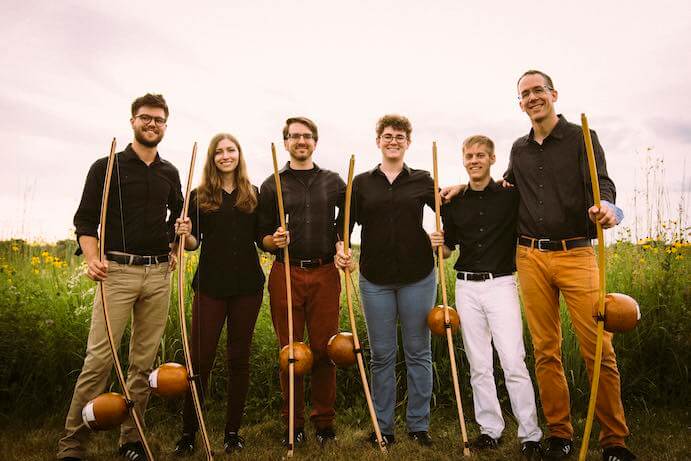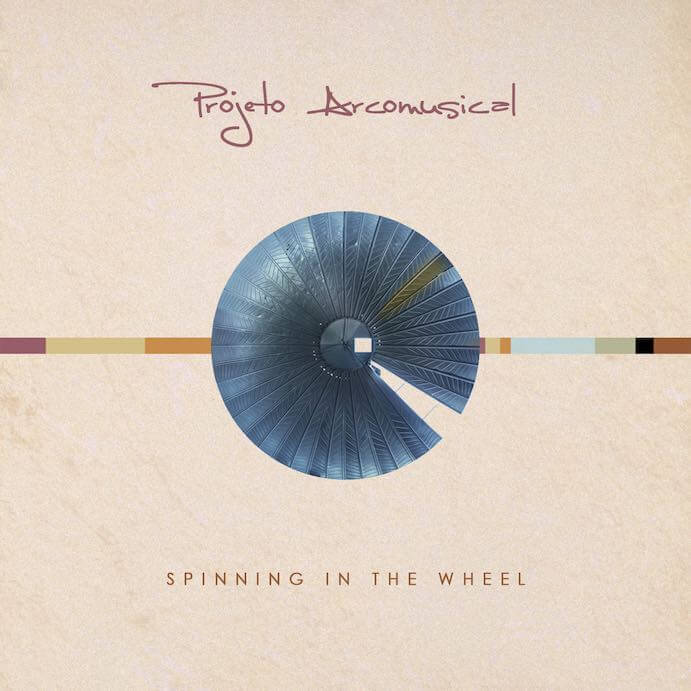Spinning in the Wheel (March 2019, National Sawdust Tracks) is the second album by Projeto Arcomusical, a non-profit focused on developing, promoting, and performing music for the berimbau. The berimbau is one example of the many varieties of musical bow instruments used in cultures around the world, and most listeners know this one specifically through its connection to Afro-Brazilian Capoeira Angola. Projeto Arcomusical released its first album of berimbau music, MeiaMeia, in 2016, and the group describes it as, “a twelve-work chamber music cycle for an instrument called the Arcomusical, an elegant species of tunable berimbau handcrafted in the United States.”
Spinning in the Wheel is a fitting follow-up to MeiaMeia, and continues to work toward the group’s mission of promoting the berimbau in a way that adds to its repertoire (instead of merely replicating it), while also allowing it to speak on its own terms. The new repertoire that Projeto Arcomusical offers on Spinning in the Wheel asks, “How can we celebrate what the berimbau is naturally good at?” in addition to asking, “What sounds is this instrument capable of making?”

Projeto Arcomusical–Photo by Four/Ten Media
On a first listen, Spinning in the Wheel feels like a jam session with a plan: friendly, welcoming, and not at all micro-managed, with as few nods to presentational performance as possible. Chamber music enthusiasts know better—effective musical synchrony doesn’t just happen—but Projeto Arcomusical’s unique sound, easy groove, and danceable writing almost makes one forget the hours of work that the members of the ensemble have put into making it sound “easy.”
Further listenings begin to reveal the structures that Projeto Arcomusical has built into the album. The seven compositions on Spinning in the Wheel are more than a collection of pieces in a sequence. The album forms a chiasmus—not a strict palindrome, but a structural one—balanced by the numbers of musicians playing on each track with Berimbau Solo No. 5 in the center. The music blends its literary and intellectual structures with technical prowess. The demands of playing this music, particularly in Berimbau Duo No. 2 and the three fast movements of Roda, require technique that would be nearly impossible to “fake.”
Elliot Cole’s four-movement Roda is the star attraction of this album and the “wheel” of the title. It is the only piece not composed by member of the ensemble. While Roda has unmistakeable influences from minimalist and process musics, these seem more like features of Cole’s compositional language than molds that he imposes on the berimbau, which serves the instrument well. Cole treats his musical ideas clearly, never allowing them to become chaotic or muddy, while at the same time maintaining a constant forward pulse in each movement. “Turning” and “Singing” drive steadily, while “Dreaming” relaxes and “Spinning” is a whirl. Of the four movements, “Spinning” is the best reminder that these musicians are percussionists first–it is a celebration of the rhythmic capabilities of the berimbau as much as the tonal ones.
Ondulação by Alexis C. Lamb has a sparkling optimism throughout. Of the pieces included, this one dances the best, reflecting the undulation of its Portuguese title, though not the most intensely. After the purposeful pulses of Roda, Ondulação is calmer, quieter, and more intimate–a pleasure in its own right. Echoes by Kyle Flens is the most atmospheric of the offerings on Spinning in the Wheel. The title reflects both the writing for individual instruments (i.e. echoes within a single part) and the cross-ensemble writing. The short, cyclical patterns from the capoeira tradition (called toques) move seamlessly between the instrumental and supporting voice parts.
The four works by Gregory Beyer–two duos (Duo No. 6 “For M & K,” and Duo No. 2 “Naná”), a solo (Solo No. 5 “For Mô”), and a sextet (Sextet No. 2 “Traíra”)–all reflect the people for whom they were written. The joy of “M&K’s” wedding is immediate. In “for Mô,” one can hear the singing, whistling, and the rhythmic allusions to Bach cantatas blooming out of the energy and camaraderie of a late-night recording session. The twirling grace of “Naná” seems like an extension of the art of Beyer’s capoeira teacher, not merely a reference to it. The sextet is the only piece that begins with singing, and is dedicated to Mestra Traíra, who released the first commercial recording of capoeira music in Brazil in 1963. Together, the four pieces begin a memoir of both the berimbau and of Projeto Arcomusical’s journey with it.
The most wonderful thing about Spinning in the Wheel is the fun that Projeto Arcomusical clearly had while making the album, and any listener can hear it immediately. As a group, they achieve simplicity without austerity and complexity without sacrificing clarity. Their ultimate ambition is to let the berimbau speak, and they are confident that it can do so in contemporary language. Their vision for this instrument makes me hopeful that others of similar mind will follow suit.























